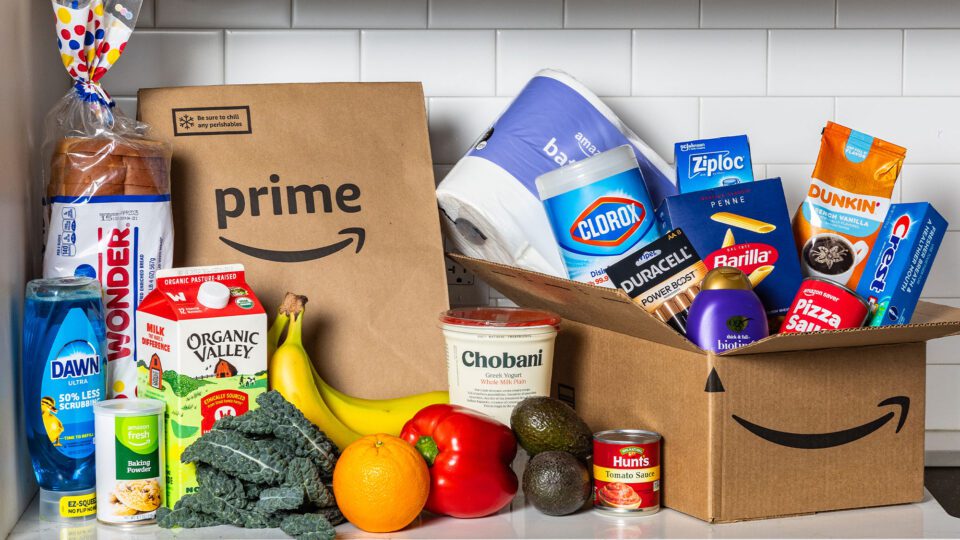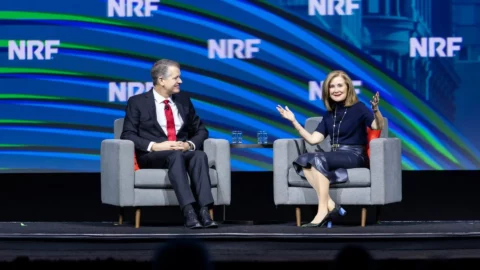This is the second story in a two-part series. Click here to view the first installment, which outlines how Everyday Essentials on Amazon.com have quietly become the engine of Amazon’s grocery business.
Amazon has spent years trialing different grocery concepts. Some have worked, some haven’t, and some are finding new steam after strategy pivots. Through it all, Sam Heyworth, the company’s VP of Consumables, said that two truths have emerged: one, customers want a seamless experience; and two, they want value.
In the second part of this two-part series, we dissect (with Heyworth’s help) the ingredients that are helping Amazon deliver on those two tenets across all its grocery channels, and how the mounting success of the Amazon.com’s Everyday Essentials business is fueling the flywheel.
Ingredient 1: Regionalization
Amazon’s yearslong effort to regionalize its fulfillment network has been a crucial unlock in terms of both customer experience and value for the whole of its business. The shift (detailed by Amazon’s CEO of Worldwide Stores Doug Herrington here) has enabled the whiplash-inducing delivery speeds that Amazon has achieved in recent years, while also making this speedy delivery affordable, even for lower-priced items.
Now that this localized warehouse network is established, the next step is what Herrington called “perfect placement,” that is, “maximizing the probability that when a customer places an order, [the product] is already in the region where they live and, better yet, already in the fulfillment center that’s closest to them.”
The company’s continued advancements in inventory placement and delivery speed have been, and will continue to be, particularly beneficial to Amazon’s Everyday Essentials business. Decreasing the time and cost it takes to get an item to a customer means that you can offer the same speedy delivery for even low-cost (or as Herrington calls them) low-ASP (average selling price) items.
“Low-ASP products are the vast majority of what any household buys, like 80% to 90%,” explained Herrington at last year’s Accelerate conference in September. “As big and successful as we are, we’re still relatively underpenetrated in those low-ASP items. So as [sellers] add those items into the system, customers are expanding their wallet with Amazon by buying more and more in those categories. The knock-on effect of that is that those new purchases are driving new shopping missions on Amazon, increased visits, increased traffic, and when they do that, they’re buying more of everything else, the higher-priced products as well.”
Not only has regionalization made it fiscally feasible for Amazon to grow its share of essentials purchases, but once Amazon captures an essentials sale, customers stay and shop other categories as well.
In 2024, Amazon delivered more than 2 billion groceries and household essentials within one day — a 50% increase year-over-year, according to Heyworth. And Herrington said there’s still room to grow, highlighting how helpful technology will be in further streamlining that perfect product placement. In fact, in its recent Q2 earnings, Amazon said that it was able to improve regional accuracy of inventory placement by 20% with AI-powered demand forecasting.
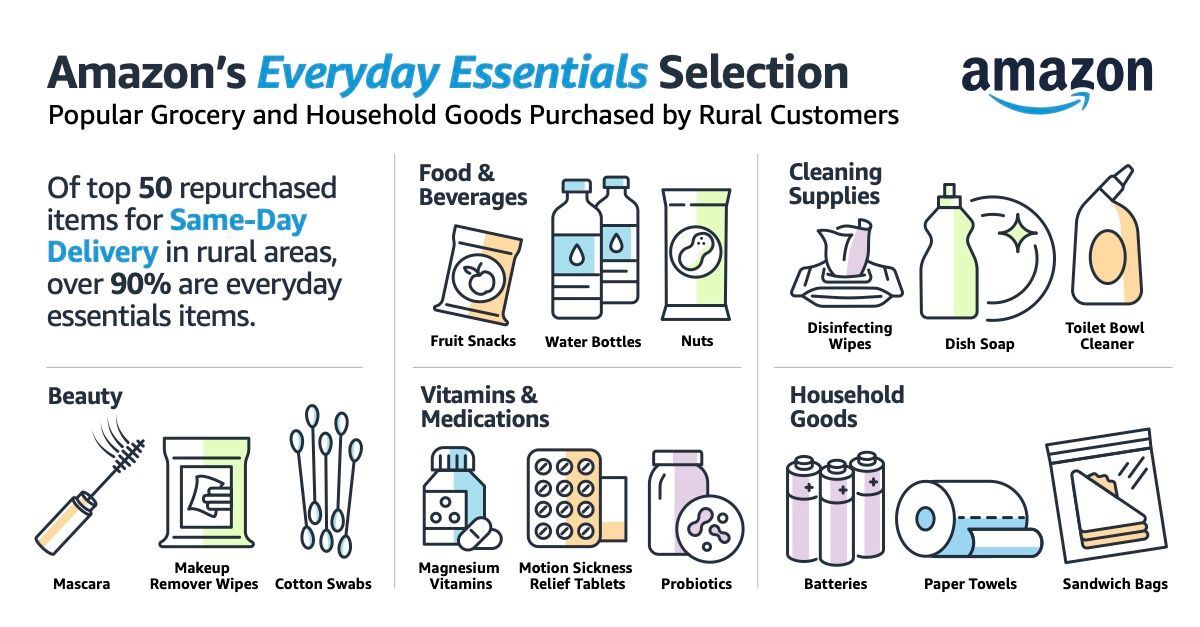
Not to mention that Amazon (like many of its competitors) is now turning its attention to rural areas, where delivery has traditionally been not just slow, but often nonexistent. The company announced in May that it will invest $4 billion to expand its delivery network to reach these customers.
“For my team specifically, this expansion improves the shopping experience for a customer segment that was previously underserved for everyday essentials,” said Heyworth. “Think about products like diapers, pet food or household cleaning supplies — bulky, routine purchases that rural customers previously had to drive significant distances to obtain. Now they can get these delivered quickly, often within a day. The impact goes beyond convenience — it’s about quality of life. When you remove the time burden of driving long distances for routine purchases, you give people back hours in their week.”
Ingredient 2: Expansion
With the logistics nut effectively cracked, Amazon has now been steadily increasing its online selection of Everyday Essentials, adding hundreds of thousands of new products, particularly at price points below $10. And with the platform’s hold over consumers now firmly established, brands are flocking on board, including big names that are firmly entrenched in everyday essentials, such as Clinique and Estée Lauder.
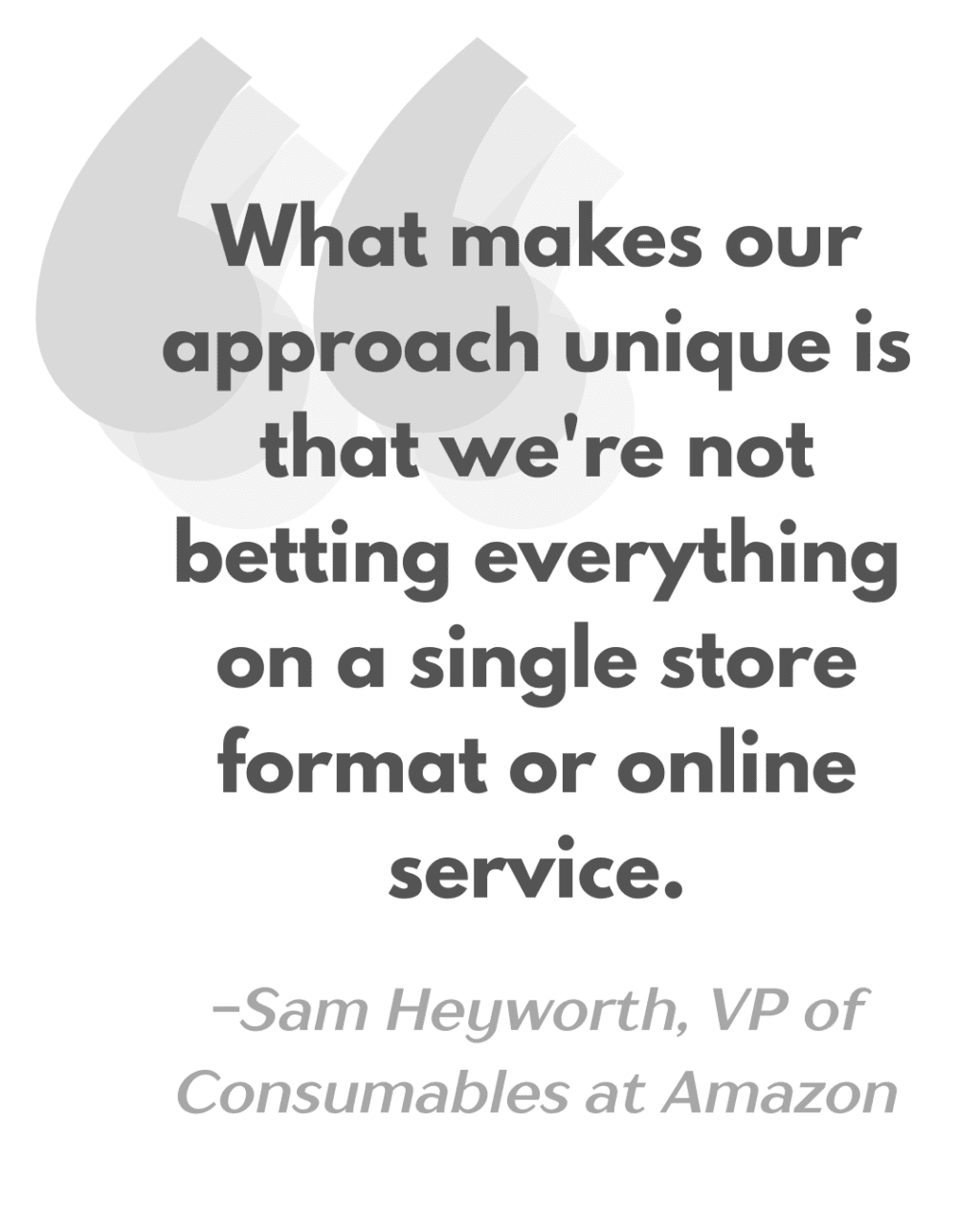
Adding to Amazon.com’s essentials lineup is an ever-growing range of items from Whole Foods and Amazon Fresh, as well as from third-party grocers including Cardenas Markets, Weis Markets, New Seasons and Metropolitan Market. And Whole Foods’ core business continues to grow since its 2017 acquisition, with sales up 40% and a store footprint topping 540 locations.
“But we’re not stopping there,” said Heyworth. “Most recently we shared that we would trial and launch new concepts like offering fresh groceries through our same-day delivery offering in Phoenix, Orlando and Kansas City, Mo., and we’re seeing a positive customer response. In fact, we’re seeing that after a customer places a few same-day delivery orders that include fresh groceries, they begin shopping Amazon Fresh and Whole Foods Market for their full-service grocery needs.”
And most of the customers who have purchased fresh food on Amazon.com where it’s currently available are new to the company’s perishables business. “That’s what offering perishables on Amazon.com with relatively little friction does — it gets more people shopping for grocery on Amazon,” he said.
Ingredient 3: Integration
What does it mean to lead the “consumables” division at a consumption hotbed like Amazon?
At Amazon, the term “consumable” is very distinctly defined: “When most people think about grocery shopping, they envision two distinct types of products: fresh foods that require refrigeration (like dairy, produce and meat) and everything else (the things you find in the center aisles of a typical grocery store),” explained Heyworth. “At Amazon, my team focuses on that ‘everything else.’”
As such, while not officially part of the Worldwide Grocery Stores division, Heyworth’s team works very closely with that group.
The connecting thread is the Prime membership: “What makes our approach unique is that we’re not betting everything on a single store format or online service,” said Heyworth. “Instead, we’re connecting different offerings through Prime membership, which provides exclusive savings, free delivery and so much more. The key to bringing this vision to life is integration — ensuring that no matter how a customer interacts with Amazon, they can access the full breadth of our grocery offerings without friction.”
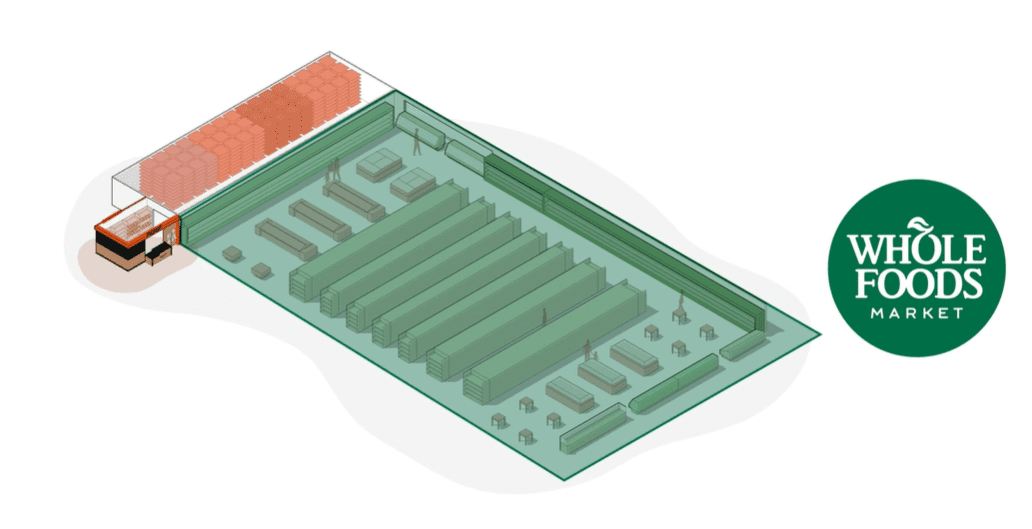
Returns drop-off and order pickups at Fresh and Whole Foods locations have long been part of the Prime grocery bundle, and now the company is deepening these integrations. One of the most recent examples is the trial of an Amazon.com microfulfillment center within a Whole Foods store.
“We know that Whole Foods Market shoppers love the high-quality natural and organic products they find in our stores, but data shows many of them also visit additional stores to grab their favorite national brands or household essentials to complete their weekly shopping,” explained Heyworth. “The microfulfillment center allows customers shopping at that Whole Foods Market location [in Plymouth, Pa.] to pick up items from Amazon.com and Amazon Fresh in a single trip, rather than having to visit multiple stores or place multiple online orders. If you’re shopping for organic produce at Whole Foods but also need Tide detergent, you can get it all in one place. It’s still early days, but we look forward to opening it to the public later this year.”
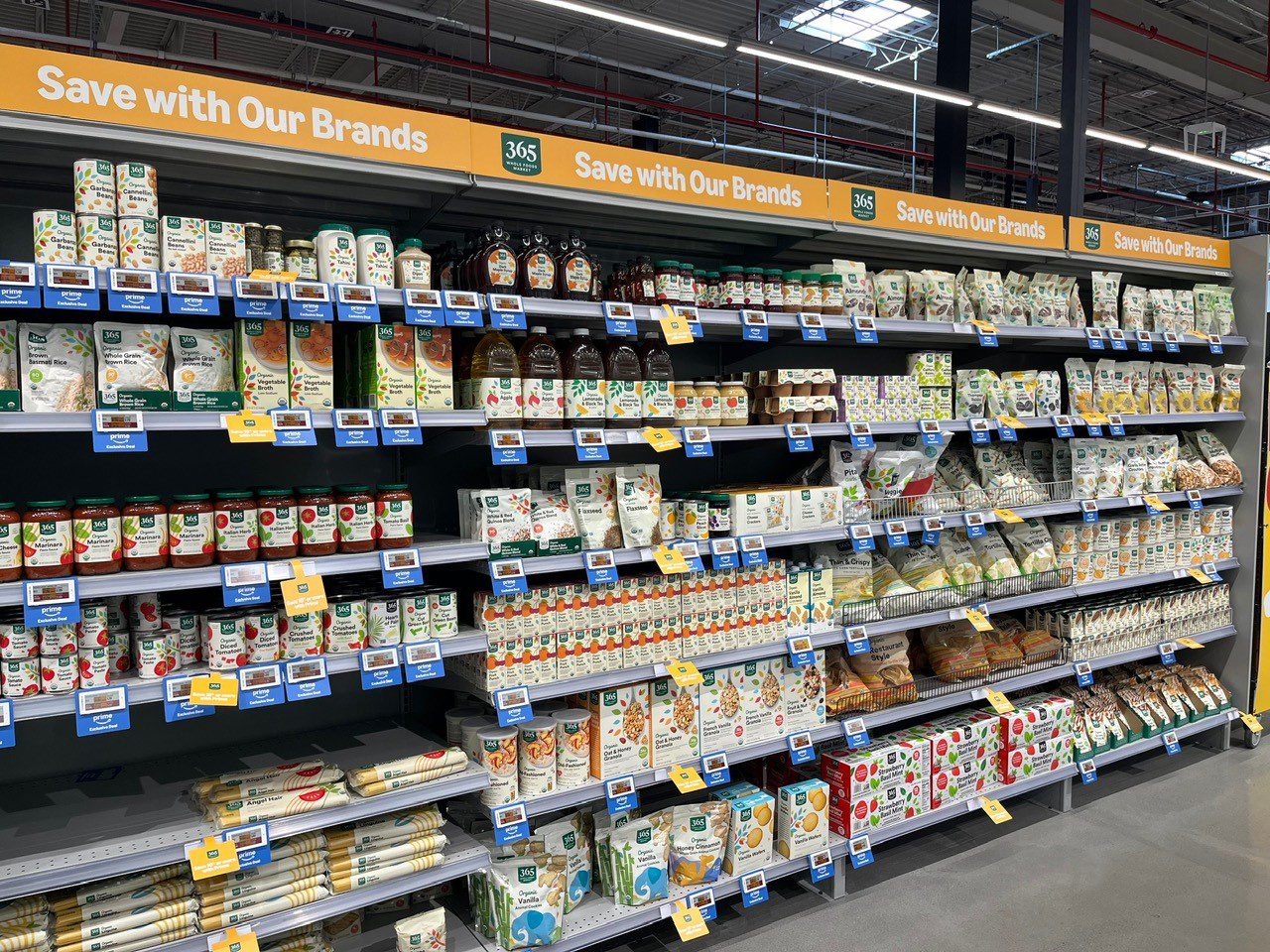
Another attempt to solve the same problem includes adding an Amazon store, like one in downtown Chicago, adjacent to Whole Foods, allowing customers to “top off” their grocery cart while in the same shopping center. And these integrations are happening in reverse at Amazon Fresh stores, which feature a broad selection of Whole Foods’ 365 private label brand, along with other offerings from the Amazon suite.
“An important piece in delivering on this strategy is to make Amazon’s organization structure invisible to customers, or to ‘hide the wires,’” added Heyworth. “Whether you’re buying fresh groceries from Whole Foods Market or Amazon Fresh, or shelf-stable snacks or household cleaning supplies from Amazon.com — the process should be seamless. We’ll do this by leveraging our existing resources and expertise rather than building entirely new solutions, which means constant collaboration with the grocery organization to ensure a cohesive experience.”
Ingredient 4: Repetition
As any merchant will tell you, even more important than the first purchase is the second. When a customer comes back and buys again, then you know you’re cooking with gas. And Amazon has a fail-safe in this regard — the long-running but oft-overlooked “Subscribe & Save” service.
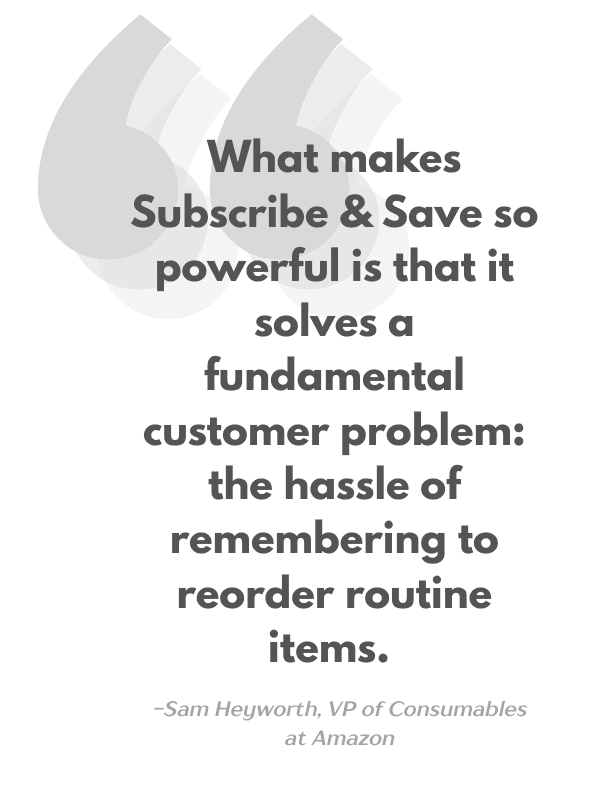
“Subscribe & Save is a hugely important part of our business that doesn’t always get the attention it deserves,” said Heyworth. “The program has tens of millions of global users with hundreds of millions of active subscriptions. What makes Subscribe & Save so powerful is that it solves a fundamental customer problem: the hassle of remembering to reorder routine items. Nobody wants to run out of dog food, diapers or coffee, but keeping track of when to reorder is mental overhead most people would rather avoid. By automating these purchases, we remove that burden while also providing savings of up to 15%.”
Those numbers illustrate how immensely successful the program is for Amazon — not just in terms of predictable repeat business but also in contributing to Herrington’s “perfect product placement” objective. Beyond being an expression of consumer loyalty and trust, “Subscribe & Save provides valuable predictability for our operations,” explained Heyworth. “When we know a customer will need a certain product on a specific schedule, we can optimize our inventory and logistics accordingly. This helps us maintain high in-stock rates and efficient delivery, which in turn leads to better customer experiences.” The Amazon flywheel at work once again.
And at a time when value is paramount to consumers, it also helps maintain Amazon’s position as the lowest-priced retailer in the U.S. (a title that the company has held for the last eight consecutive years in Profitero’s ranking). In the last 12 months, Subscribe & Save has passed on more than $2 billion in savings, $1.6 billion in the U.S. alone.
Taken together, the picture is one not of a digital disruptor flailing at traditional brick-and-mortar, but a proven innovator testing and figuring out what works in a complex, highly personal category. And when viewed from that vantage point it’s hard not to feel like Amazon’s grocery flywheel is just picking up speed.
For another angle on Amazon’s Everyday Essentials business, check out this recent episode of Retail Remix with Adobe Digital Insight’s Vivek Pandya, who dissects category sales performance during Prime Day in July to foretell what lies ahead for the holiday season:




